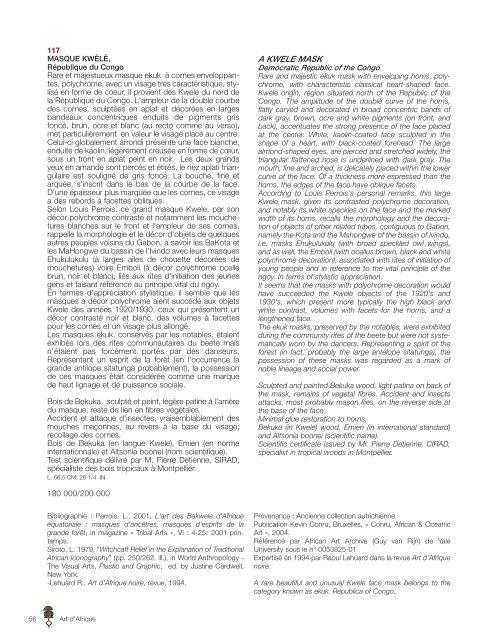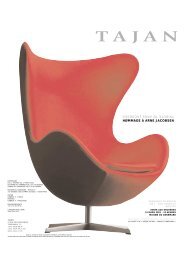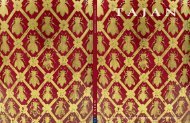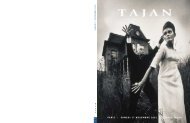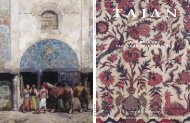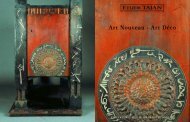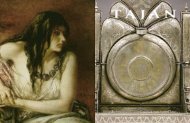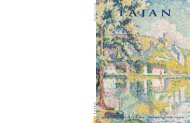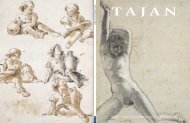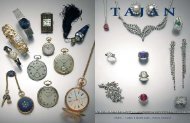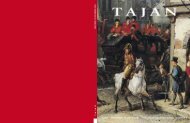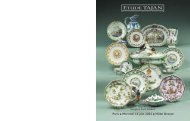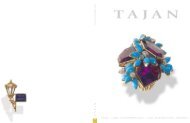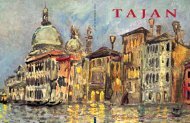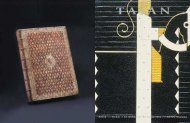Arts Premiers - Tajan
Arts Premiers - Tajan
Arts Premiers - Tajan
Create successful ePaper yourself
Turn your PDF publications into a flip-book with our unique Google optimized e-Paper software.
117<br />
MASQUE KWÉLÉ,<br />
République du Congo<br />
Rare et majestueux masque ekuk à cornes enveloppantes,<br />
polychrome, avec un visage très caractéristique, stylisé<br />
en forme de coeur. Il provient des Kwele du nord de<br />
la République du Congo. L'ampleur de la double courbe<br />
des cornes, sculptées en aplat et décorées en larges<br />
bandeaux concentriques enduits de pigments gris<br />
foncé, brun, ocre et blanc (au recto comme au verso),<br />
met particulièrement en valeur le visage placé au centre.<br />
Celui-ci globalement arrondi présente une face blanche,<br />
enduite de kaolin, légèrement creusée en forme de cœur,<br />
sous un front en aplat peint en noir. Les deux grands<br />
yeux en amande sont percés et étirés, le nez aplati triangulaire<br />
est souligné de gris foncé. La bouche, fine et<br />
arquée, s'inscrit dans le bas de la courbe de la face.<br />
D'une épaisseur plus marquée que les cornes, ce visage<br />
a des rebords à facettes obliques.<br />
Selon Louis Perrois, ce grand masque Kwele, par son<br />
décor polychrome contrasté et notamment les mouchetures<br />
blanches sur le front et l'ampleur de ses cornes,<br />
rappelle la morphologie et le décor d'objets de quelques<br />
autres peuples voisins du Gabon, à savoir les BaKota et<br />
les MaHongwe du bassin de l'Ivindo avec leurs masques<br />
Ehukulukulu (à larges ailes de chouette décorées de<br />
mouchetures) voire Emboli (à décor polychrome ocellé<br />
brun, noir et blanc), liés aux rites d'initiation des jeunes<br />
gens et faisant référence au principe vital du ngoy.<br />
En termes d'appréciation stylistique, il semble que les<br />
masques à décor polychrome aient succédé aux objets<br />
Kwele des années 1920/1930, ceux qui présentent un<br />
décor contrasté noir et blanc, des volumes à facettes<br />
pour les cornes et un visage plus allongé.<br />
Les masques ekuk, conservés par les notables, étaient<br />
exhibés lors des rites communautaires du beete mais<br />
n'étaient pas forcément portés par des danseurs.<br />
Représentant un esprit de la forêt (en l'occurrence la<br />
grande antilope sitatunga probablement), la possession<br />
de ces masques était considérée comme une marque<br />
de haut lignage et de puissance sociale.<br />
Bois de Bekuka sculpté et peint, légère patine à l'arrière<br />
du masque, reste de lien en fibres végétales.<br />
Accident et attaque d'insectes, vraisemblablement des<br />
mouches maçonnes, au revers à la base du visage;<br />
recollage des cornes.<br />
Bois de Bekuka (en langue Kwele), Emien (en norme<br />
internationnale) et Altsonia boonei (nom scientifique).<br />
Test scientifique délivré par M. Pierre Detienne, SIRAD,<br />
spécialiste des bois tropicaux à Montpellier.<br />
L. 66,5 CM; 26 1/4 IN<br />
A KWELE MASK<br />
Democratic Republic of the Congo<br />
Rare and majestic ekuk mask with enveloping horns, polychrome,<br />
with characteristic classical heart-shaped face.<br />
Kwele origin, region situated north of the Republic of the<br />
Congo. The amplitude of the double curve of the horns,<br />
flatly carved and decorated in broad concentric bands of<br />
dark gray, brown, ocre and white pigments (on front, and<br />
back), accentuates the strong presence of the face placed<br />
at the center. White, kaolin-coated face sculpted in the<br />
shape of a heart, with black-coated forehead. The large<br />
almond-shaped eyes, are pierced and stretched widely, the<br />
triangular flattened nose is underlined with dark gray. The<br />
mouth, fine and arched, is delicately placed within the lower<br />
curve of the face. Of a thickness more espressed than the<br />
horns, the edges of the face have oblique facets.<br />
According to Louis Perrois's personal remarks, this large<br />
Kwele mask, given its contrasted polychrome decoration,<br />
and notably its white speckles on the face and the marked<br />
width of its horns, recalls the morphology and the decoration<br />
of objects of other related tribes, contiguous to Gabon,<br />
namely the Kota and the Mahongwe of the bassin of Ivindo,<br />
i.e. masks Ehukulukulu (with broad speckled owl wings),<br />
and as well, the Emboli (with ocellus brown, black and white<br />
polychrome decoration), associated with rites of initiation of<br />
young people and in reference to the vital principle of the<br />
ngoy. In terms of stylistic appreciation.<br />
It seems that the masks with polychrome decoration would<br />
have succeeded the Kwele objects of the 1920's and<br />
1930's, which present more typically the high black and<br />
white contrast, volumes with facets for the horns, and a<br />
lengthened face.<br />
The ekuk masks, preserved by the notables, were exhibited<br />
during the community rites of the beete but were not systematically<br />
worn by the dancers. Representing a spirit of the<br />
forest (in fact, probably the large antelope sitatunga), the<br />
possession of these masks was regarded as a mark of<br />
noble lineage and social power.<br />
Sculpted and painted Bekuka wood, light patina on back of<br />
the mask, remains of vegetal fibres. Accident and insects<br />
attacks, most probably mason flies, on the reverse side at<br />
the base of the face.<br />
Minimal glue restoration to horns.<br />
Bekuka (in Kwele) wood, Emien (in international standard)<br />
and Altsonia boonei (scientific name).<br />
Scientific certificate issued by Mr. Pierre Detienne, CIRAD,<br />
specialist in tropical woods in Montpellier.<br />
180 000/200 000<br />
Bibliographie : Perrois, L., 2001, L'art des Bakwele d'Afrique<br />
équatoriale : masques d'ancêtres, masques d'esprits de la<br />
grande forêt, in magazine « Tribal <strong>Arts</strong> », VI : 4-25/ 2001 printemps.<br />
Siroto, L. 1979, “Witchcaft Relief in the Explanation of Traditional<br />
African Iconography” (pp. 250/262, ill.), in World Anthropology -<br />
The Visual <strong>Arts</strong>, Plastic and Graphic, ed. by Justine Cardwell,<br />
New York.<br />
-Lehuard R., Art d'Afrique noire, revue, 1994.<br />
Provenance : Ancienne collection autrichienne.<br />
Publication Kevin Conru, Bruxelles, « Conru, African & Oceanic<br />
Art », 2004.<br />
Référencé par African Art Archive (Guy van Rijn) de Yale<br />
University sous le n° 0053825-01<br />
Expertisé en 1994 par Raoul Lehuard dans la revue Art d'Afrique<br />
noire.<br />
A rare beautiful and unusual Kwele face mask belongs to the<br />
category known as ekuk. Republica of Congo.<br />
56 Art d’Afrique


